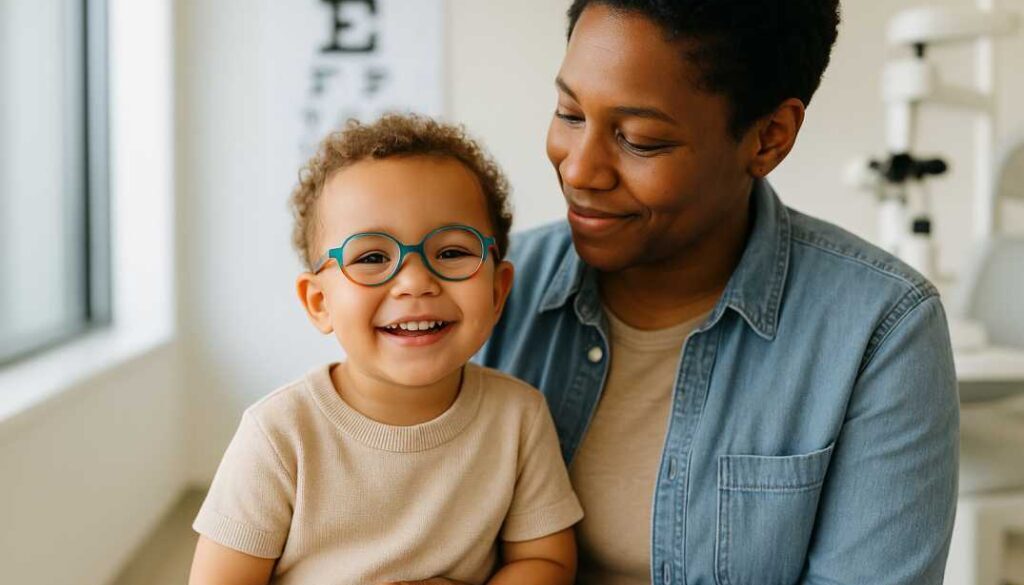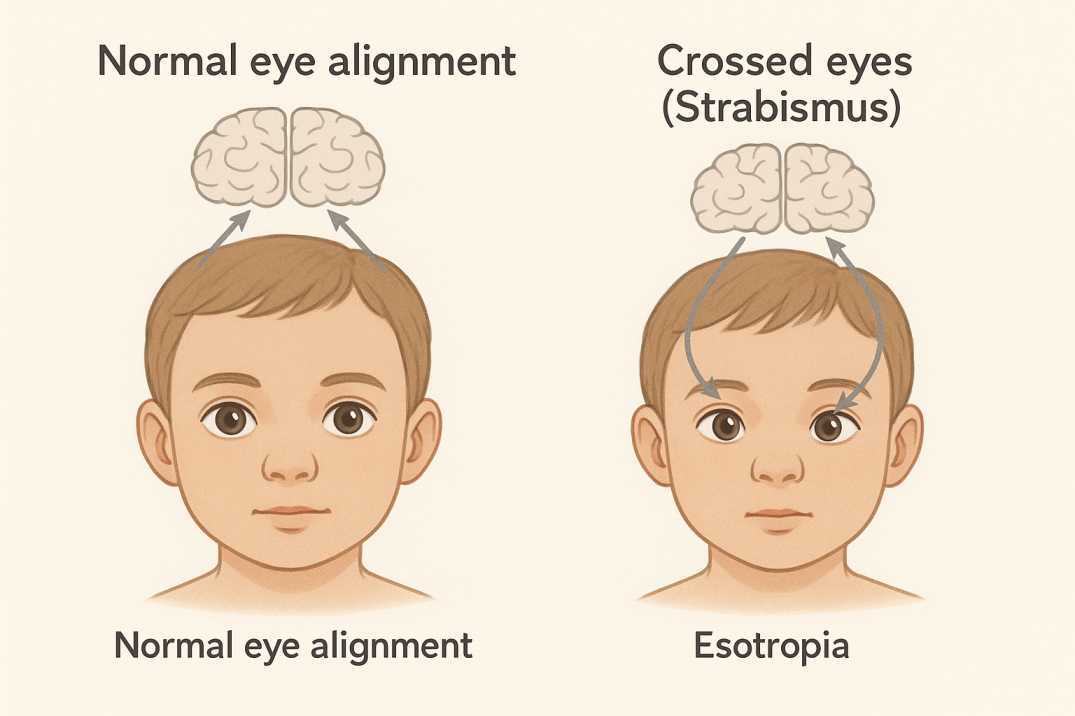Crossed Eyes in Children: Why Early Treatment Matters

When your child’s eyes don’t align properly, timing is everything. Understanding the critical window for crossed eyes treatment can mean the difference between lifelong vision challenges and clear, confident sight for your little one.
If you’ve noticed your toddler’s eyes occasionally turning inward or outward, you’re not alone—and your concern is completely justified. Crossed eyes, medically known as strabismus, affects approximately 2-4% of children worldwide, making it one of the most common childhood vision conditions. However, what many parents don’t realize is that the window for optimal crossed eyes treatment is much narrower than they might expect.
Understanding Crossed Eyes: More Than Just Appearance
Crossed eyes occur when the eyes fail to work together as a team, with one or both eyes turning inward (esotropia), outward (exotropia), upward, or downward. While it might seem like a simple muscle problem, strabismus actually stems from the brain’s inability to properly coordinate eye movements and merge visual information from both eyes.
The Hidden Impact Beyond Cosmetics
Beyond the visible misalignment that concerns parents, untreated crossed eyes can lead to:
- Amblyopia (lazy eye): The brain begins ignoring signals from the misaligned eye
- Permanent vision loss: Studies show 13.3% of children with strabismus develop amblyopia
- Poor depth perception: Critical for sports, driving, and daily activities
- Psychosocial challenges: Studies show children as young as 5 years old express negative feelings about peers with crossed eyes
Critical Timing for Crossed Eyes Treatment: When Normal Becomes Concerning
Birth to 4 Months: The Normal Development Period
During the first few months of life, it’s completely normal—and expected—for newborns’ eyes to wander or cross occasionally. Their eye muscles and neural connections are still developing, and intermittent eye crossing represents a natural part of this maturation process.
4-6 Months: The Critical Treatment Window Opens
By 4-6 months of age, your baby’s visual system should have matured sufficiently for their eyes to focus on small objects while remaining straight and well-aligned. This developmental milestone marks when the critical neural pathways between the eyes and brain are actively forming. If crossed eyes persist beyond this age, immediate professional evaluation becomes essential for optimal treatment outcomes.
Recognizing the Warning Signs
Key indicators that warrant immediate professional attention:
- Eyes that continue to wander or cross after 6 months of age
- Consistent turning of one eye, even if intermittent
- A child frequently tilting or turning their head to look at objects
- Excessive squinting, particularly in bright lighting conditions
- Closing one eye when looking at nearby objects
- Complaints of double vision in verbal children
The Two Primary Types of Childhood Crossed Eyes
Infantile Esotropia: Early-Onset Misalignment
This condition is characterized by significant inward turning of the eyes that develops within the first 6 months of life. Infantile esotropia typically requires surgical intervention due to the large angle of deviation. However, even following successful surgery, vision therapy is often necessary to develop proper binocular function and depth perception.
Accommodative Esotropia: The Most Common Form
Accommodative esotropia represents the most frequently encountered cause of eye-crossing in children under 5 years of age. This condition occurs when excessive farsightedness forces the child’s focusing system to work overtime, inadvertently triggering the eyes to turn inward.
The encouraging news? This type often responds exceptionally well to corrective eyewear alone.
Dr. Sean Donahue, chief of pediatric ophthalmology at Monroe Carell Jr. Children’s Hospital at Vanderbilt, explains: “Accommodative esotropia results from excessive farsightedness, and the need to focus the eyes produces an inward crossing of the eyes. Treatment involves correcting the farsightedness with glasses, and these children typically achieve excellent outcomes.”
Crossed Eyes Treatment Options: From Glasses to Surgery to Vision Therapy
Non-Surgical Treatments: The First Line of Defense
Corrective Glasses For accommodative esotropia, properly prescribed glasses can eliminate the eye crossing. Many children need only glasses and maintain excellent alignment when wearing them.
Eye Patching When amblyopia develops alongside strabismus, patching the stronger eye for 2-6 hours daily forces the weaker eye to work harder. While traditional studies suggested high success rates, recent research indicates that treatment effectiveness varies significantly based on timing and individual factors.
Vision Therapy: The Game-Changing Alternative Vision therapy represents a revolutionary approach to treating crossed eyes without surgery. This specialized program uses targeted exercises, special lenses, and activities to retrain the brain-eye connection.
Recent research demonstrates impressive success rates:
- 75-87% success rate for functional binocular vision
- 88% effectiveness for convergence insufficiency
- Significant improvement in depth perception and eye coordination
At Cook Vision Therapy Center, our 30+ years of experience with non-surgical strabismus treatment has shown that vision therapy can often eliminate the need for surgery while developing true 3D vision—something surgery alone cannot achieve. [Learn more about our vision therapy approach and success stories]
Surgical Intervention: When and Why
Surgery becomes necessary when:
- Non-surgical methods haven’t achieved adequate alignment
- The angle of deviation is too large for other treatments
- Infantile esotropia is present
Understanding Surgical Success Rates Recent studies provide more nuanced data on surgical outcomes. A 2024 multi-center study found overall surgical success rates of 74.19% in children, with success defined as achieving proper eye alignment. However, functional success rates vary significantly by condition type and age at treatment.
The Scientific Foundation for Early Intervention
The Critical Period of Visual Development
The human visual system undergoes rapid and complex development during the first 8 years of life, with peak neuroplasticity occurring before age 6. During this crucial window, key connections between the eyes and brain establish permanent neural pathways that determine lifelong visual function.
Dr. Brian G. Mohney from the Mayo Clinic emphasizes this critical timing: “The earlier strabismus is treated, the more favorable the outcome. This is because essential connections between a child’s eyes and brain form by approximately 8 years of age.”
Research-Backed Evidence for Early Treatment
Study 1: The Baltimore Pediatric Eye Disease Study (2009)
This landmark population-based study of 1,739 children demonstrated that early detection and treatment of strabismus significantly enhanced long-term visual outcomes. Children who received treatment before age 5 demonstrated markedly superior binocular function compared to those treated at later ages.
Study 2: Pediatric Strabismus Surgery Outcomes (2024)
A recent comprehensive study analyzing 342 children revealed a 74.19% surgical success rate in infants, with factors like preoperative angle of deviation and presence of amblyopia affecting outcomes. The research emphasized that smaller deviation angles (less than 50 prism diopters) were associated with better surgical results.
Study 3: Vision Therapy Effectiveness Research (2024)
A comprehensive review published in Clinical Insights in Eyecare demonstrated that motivated children and adults can achieve functional binocular vision through structured vision therapy programs, even years after the traditional “critical period.” This groundbreaking research challenges previous assumptions about treatment windows.
Taking Action: Your Comprehensive Guide to Next Steps
When Professional Evaluation Becomes Urgent
Seek immediate professional consultation if:
- Eye crossing persists beyond 6 months of age
- Sudden onset of strabismus occurs after age 6 (may indicate serious underlying conditions)
- Your child displays signs of visual discomfort or difficulty
- Family history includes strabismus or significant refractive errors
What to Expect During a Comprehensive Evaluation
A thorough strabismus assessment encompasses:
- Complete ocular health examination
- Precise assessment of eye alignment and movement patterns
- Comprehensive evaluation for amblyopia development
- Detailed measurement of refractive errors
- Testing of binocular function and depth perception capabilities
Selecting the Right Treatment Specialist
Look for practitioners who demonstrate:
- Specific expertise in pediatric strabismus management
- Comprehensive approach offering both surgical and non-surgical options
- Track record of successful treatment outcomes
- Commitment to thorough binocular vision assessments
At Cook Vision Therapy Center, we offer specialized expertise, including:
- Four decades of clinical experience with Dr. David Cook
- Exclusive focus on non-surgical treatment protocols
- Emphasis on developing functional 3D vision
- Comprehensive evaluation and individualized treatment planning
The Long-Term Perspective: Benefits Beyond Childhood
Academic and Social Advantages of Early Treatment
Early intervention for crossed eyes extends far beyond simple vision correction, providing:
- Enhanced academic performance: Children with successfully treated strabismus demonstrate improved reading comprehension and sustained attention
- Increased social confidence: Properly aligned eyes contribute significantly to positive self-image and successful peer interactions
- Expanded career opportunities: Research indicates that untreated strabismus can negatively impact employment prospects due to unconscious bias
Adult Treatment: Challenging Previous Assumptions
Recent research fundamentally challenges the traditional belief that treatment after the “critical period” proves ineffective. Adults with crossed eyes can still achieve meaningful benefits through:
- Vision therapy for functional improvement: Structured programs can enhance binocular coordination
- Surgical correction for alignment: Modern techniques offer excellent cosmetic and functional outcomes
- Combined treatment approaches: Integrated protocols often yield optimal results
Additional Resources and Key Citations
Essential Professional Resources
1. American Academy of Ophthalmology – Strabismus in Children
https://www.aao.org/eye-health/diseases/strabismus-in-children
Comprehensive medical reference providing authoritative information on pediatric strabismus diagnosis, treatment options, and clinical guidelines from leading ophthalmologists.
2. National Eye Institute – Amblyopia (Lazy Eye)
https://www.nei.nih.gov/learn-about-eye-health/eye-conditions-and-diseases/amblyopia-lazy-eye
Government health resource offering evidence-based information on amblyopia causes, symptoms, and treatment approaches, including the latest research on critical treatment periods.
3. Global Prevalence Study – Nature Scientific Reports
https://www.nature.com/articles/s41598-021-93131-w The
2021 Hong Kong Children Eye Study provides current prevalence data (3.11%) and risk factors for strabismus in school-aged children, representing the most recent population-based research.
Moving Forward: Hope and Decisive Action
If you’ve observed signs of crossed eyes in your child, remember that early intervention provides the greatest opportunity for successful treatment outcomes. The visual system’s remarkable neuroplasticity during childhood means that with appropriate professional intervention, most children can achieve excellent visual function.
Essential Takeaways for Parents:
- Never adopt a “wait and see” approach with suspected crossed eyes
- Seek professional evaluation by 6 months if concerns persist beyond normal development
- Consider all available treatment options, including evidence-based non-surgical vision therapy
- Prioritize functional vision improvement over purely cosmetic considerations
Ready to Take the Next Step?
At Cook Vision Therapy Center, we’ve successfully helped thousands of children and adults overcome crossed eyes through our specialized non-surgical methodology. Our comprehensive evaluation process will determine the most appropriate crossed eyes treatment pathway for your child’s unique circumstances.
Contact us today to schedule your consultation and provide your child with the gift of clear, confident vision.
Don’t delay—early intervention consistently provides the most favorable outcomes for crossed eyes treatment success.
This article is intended for educational purposes and should not substitute for professional medical consultation. Always consult with a qualified eye care professional for proper diagnosis and personalized treatment recommendations.
FAQs
-
Most crossed eyes in newborns resolve by 4-6 months. See a pediatric ophthalmologist if crossing persists after 6 months or worsens.



